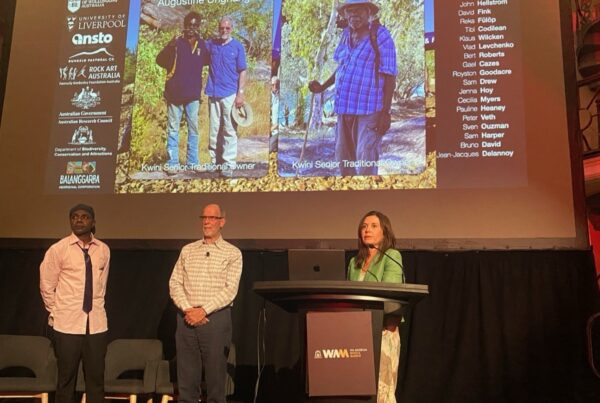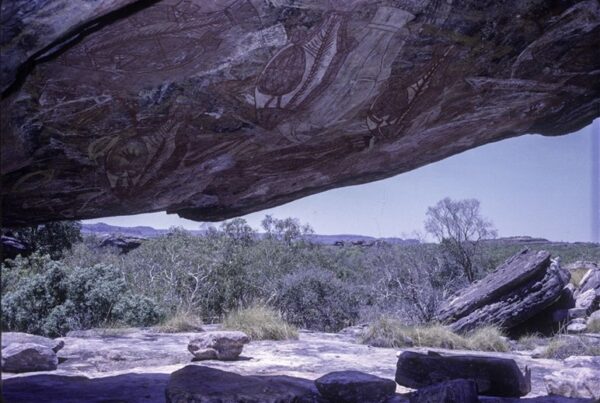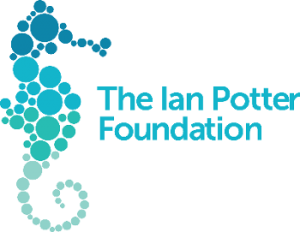Elders Dorothy Djangara and Bernadette Waina plus community members Ainslie Donation and Ian Waina brought the Outdoor School students to several cultural sites during the Women’s Cultural Education Project.
Welcome to the September Edition of Rock Art Australia’s e-News
In this edition of the newsletter, we are pleased to share the ways Rock Art Australia continues to support the next generation of scientists, cultural leaders, and community partnerships in the protection and understanding of Australia’s rock art heritage.
Across multiple regions and disciplines, our researchers, working closely with Traditional Owners, Elders, and community members, have delivered meaningful outcomes through science, storytelling, and knowledge-sharing. We have also deepened our commitment to education and capacity-building, fostering new leadership through outreach programs and mentoring the rising stars of Australian science and cultural heritage stewardship.
At Rock Art Australia, we are focused on the future. Through long-term investment in collaborative research and community-driven initiatives, we are unlocking new understandings of Australia’s deep history, while building the scientific and cultural leadership that will sustain this work for generations to come.
Latest Updates
In this edition, you’ll find stories that bring this mission to life, including:
- International collaboration using non-invasive techniques to analyse ancient pigments
- Reflections on leadership, mentorship, and two-way learning in rock art research
- A new school outreach initiative in the Kimberley engaging young people in cultural heritage and science
- Recognition of early-career research and excellence in science communication
- Climate-focused fieldwork in Western Arnhem Land shaping future research projects
- Major digitisation efforts preserving over 25,000 rock art archive images for future generations
- A women-led cultural education project strengthening intergenerational knowledge sharing on Country
You’ll find highlights from recent peer-reviewed research, including:
- Scientific insights into how Kimberley sandstone shelters form, evolve and eventually collapse
- New discoveries about ancient ceremonial cave markings and the cultural significance of finger flutings
Leadership Update
This newsletter marks my final message to you as CEO of Rock Art Australia, as I have accepted the role of Director of the South Australian Museum, an opportunity that aligns seamlessly with my experience in the museum and gallery sector, working with Indigenous and scientific collections.
I am delighted to advise that former CEO, Cas Bennetto, will return as interim CEO to steer the organisation over the next few months.
I am also delighted to share that Dr Helen Green, Chair of RAA’s Science Advisory Council, has been appointed Director of Research. In this role, Helen will lead our national research program and strengthen engagement with stakeholders. Many of you will already know Helen from her award-winning work on the Rock Art Dating Project. You can read more about her inspiring journey from emerging scientist to national leader and passionate advocate for the next generation in our Conversations Segment HERE
I will complete my tenure at RAA at the end of September 2025 and depart with deep pride in all that we have achieved together, confident in the organisation’s strength and bright future.
It has been a great privilege to serve as CEO of RAA, alongside such a dedicated Board, talented team, committed partners, and generous supporters. Over the past two years, together we have:
- Delivered a national research program, broadened RAA’s reach beyond the Kimberley, and positioned the organisation as a national research supporter.
- Launched a highly successful national lecture, book and film series, connecting audiences across the country with RAA’s mission and impact.
- Strengthened partnerships with Indigenous communities and research institutions, continuing to bring together Indigenous knowledge and science as central to our work.
- Expanded RAA’s philanthropic base and corporate partnerships, building sustainability and support for future initiatives.
I extend my heartfelt gratitude for your support and collaboration and will continue to value and advocate for the crucial work RAA does.
Best wishes,
Dr Samantha Hamilton. CEO
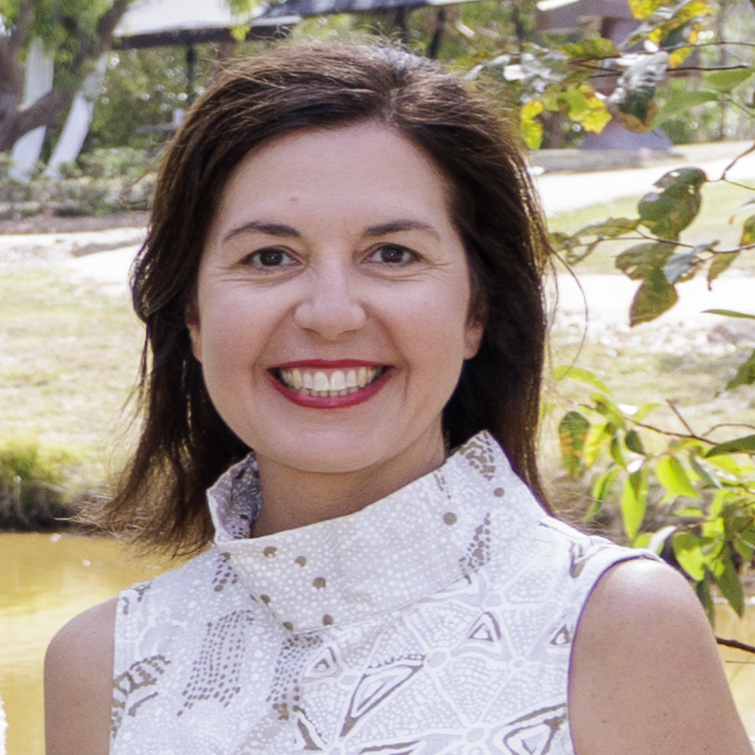
Welcome Charmaine Cinnabar
We are delighted to welcome Charmaine Cinnabar as a new member and student representative on Rock Art Australia’s Science Advisory Council (SAC). Charmaine is a proud Djabuganjdji and Gimuy Walubara Yidinji woman from Redlynch, Cairns, and Palm Island. She holds a Bachelor of Animal Ecology from the University of the Sunshine Coast and is currently completing a Master of Science in Tropical Biology at James Cook University, where she also works as a Project Officer for the ATSIMS (Aboriginal and Torres Strait Islander Marine Science) program. Charmaine recently participated in the Coral Sea Foundation’s Sea Women Great Barrier Reef training program, gaining hands-on experience in marine conservation alongside Indigenous women from Australia, Papua New Guinea, and the Torres Strait Islands.
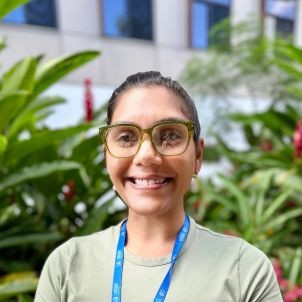
Deeply committed to preserving and promoting Indigenous ecological knowledge, customs, and traditions, she advocates for embedding this knowledge at the heart of scientific research and conservation.
Through her strong community connections, cultural insight, and research experience, Charmaine will be an invaluable addition to the SAC, and we warmly welcome her to the Council.
From the Rock Art Australia Minderoo Chair in Archaeological Science, Rachael Popelka-Filcoff
Professor Rachel Popelka-Filcoff, Visitng Professorship in Paris and France
Prof Rachel Popelka-Filcoff was in Paris region and other parts of France for three weeks in July as part of an invited visiting professorship through the DIM PAMIR scheme. The scheme (DIM Patrimoines matériels – innovation, expérimentation, résilience (PAMIR) is the Ile-de-France research network dedicated to the study of heritage sciences.
This unique scientific collaboration aims to advance the understanding of the materials used in rock art through state-of-the-art, non-invasive analytical techniques and fostering international synergy on rock art research. The TraceRockArt project promotes a dynamic research partnership between France and Australia, also involving collaborators from Italy and Spain. The collaboration brings together international experts Ina Reiche (Lab-BC), Katharina Müller (IPANEMA), and Sebastian Schöder and Kadda Medjoubi (SOLEIL Synchrotron) with the Archaeological Science Laboratory (University of Melbourne). Together, the team conducted joint experiments on the NANOSCOPIUM beamline at Synchrotron SOLEIL focused on pigments and co-organized a scientific workshop at the C2RMF with scientific experts focused on cutting-edge, non-destructive analytical methods applied to ancient pigments “Prehistoric pigments vs. large scale facilities”.
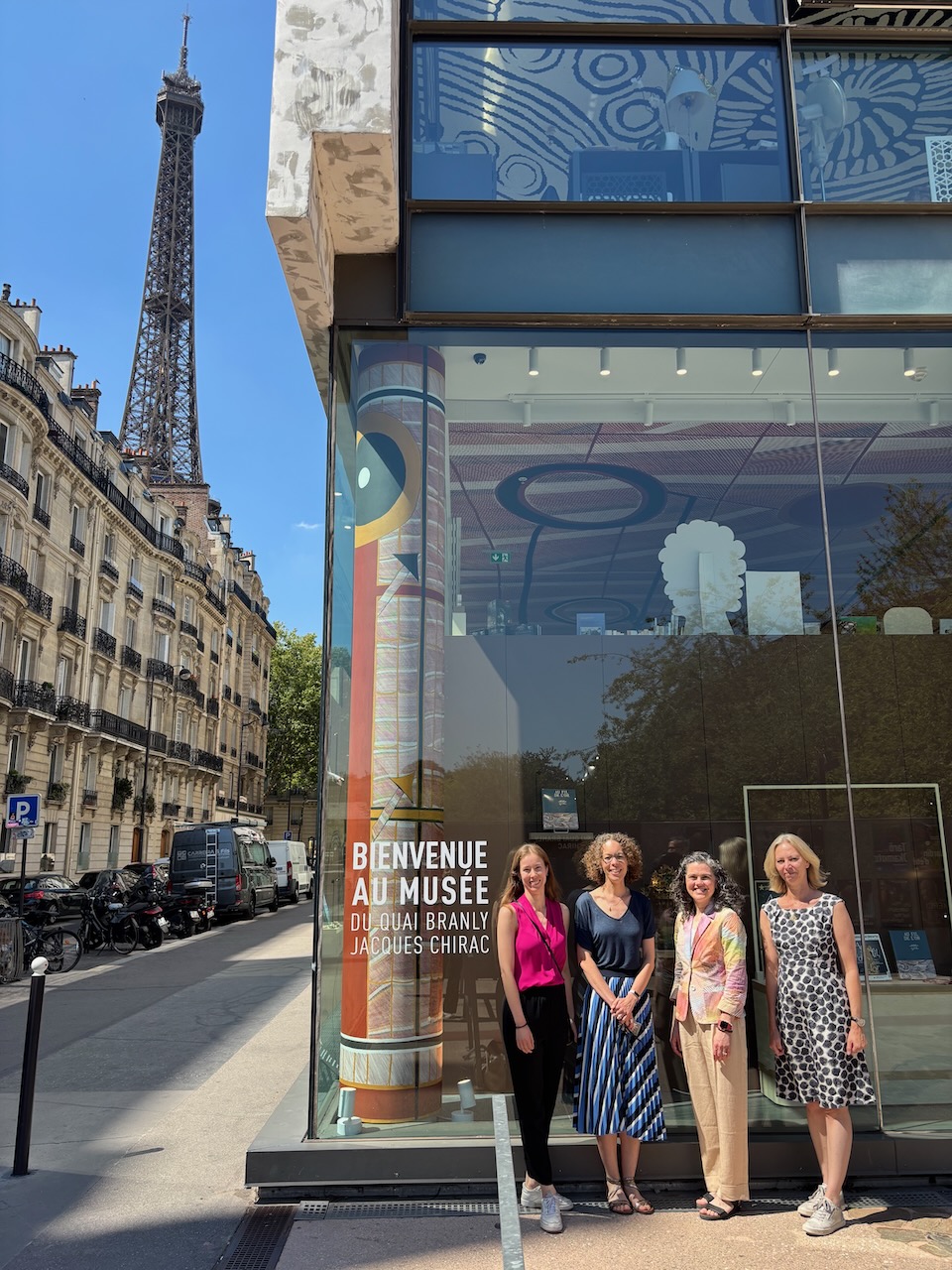
At invited presentation at Musee du Quai Branly Jacque Chirac: (L-R) Julie Gordon, Stephanie Leclerc Caffarel, Rachel Popelka-Filcoff and Ina Reiche
Prof Popelka-Filcoff also delivered a series of invited lectures in the Paris region and France (C2RMF-Louvre, SOLEIL, Musee du Quai Branly and University of Savoie Montblanc-EDYTEM). She also attended the opening of a scientific exhibit at Chauvet, as well as discussed research and visited several rock art sites including the copies at Chauvet, Lascaux and prehistoric sites Trou de la Féclaz, Abri Petaud, Grotte des Combarelles, and Font De Gaume.
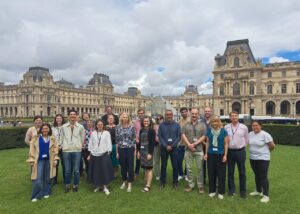
Expert workshop participants at the “Prehistoric pigments vs. large scale facilities” at the C2RMF Louvre
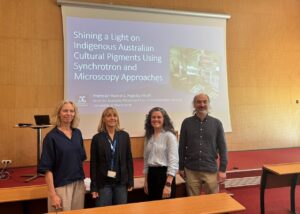
Presenting at SOLEIL Synchrotron: (L-R) Ina Reiche, Katharina Müller, and Sebastian Schöder
From RAA’s Science Advisory Council Chair Dr Helen Green
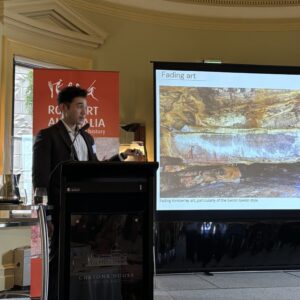

Left: Faris Ruzain presenting at Rock Art Australia’s annual Science Advisory Council Research Workshop, 2025 in Brisbane.
Please join me in congratulating Faris Ruzain, one of our outstanding PhD students, who has been selected as a national finalist in the FameLab 2025 Science Communication Competition, the prestigious international contest dedicated to discovering and supporting the next generation of science communicators.
From a pool of over 120 applicants across universities and research institutions throughout Australia, Faris has emerged as one of only 12 national finalists. His engaging and accessible presentation on his PhD research into the radiocarbon dating of rock art-associated materials impressed a distinguished panel of scientists, communication experts, and award-winning science speakers, earning him top place in the Victorian semi-final.
On the 18th of September, Faris will represent The University of Melbourne as its sole finalist at the live national finals in Perth. The event will be livestreamed globally and held in front of an audience of government officials, scientists, and members of the public at the Western Australian Museum Boola Bardip. The winner of FameLab Australia 2025 will go on to represent the country at the international FameLab final in November, held at the Science Gateway at CERN in Geneva, Switzerland.
In preparation, Faris joined us on a visit to Kalumburu on Balanggarra Country to further refine his planned presentation with community members and rangers who have partnered on this endeavour. He will also undertake further training in science communication at the Forrest Research Foundation, further sharpening his skills.
This is a brilliant achievement that reflects not only Faris’s research excellence but also his passion and talent for making science accessible and engaging to broader audiences.
Congratulations, Faris-we are very proud of you and wish you every success in the finals!
For more about FameLab Australia, click on the link below.
Inspiring the Next Generation: A Conversation with Dr Helen Green.
Championing Two Way Science, Cultural Leadership, and Community Driven Research.
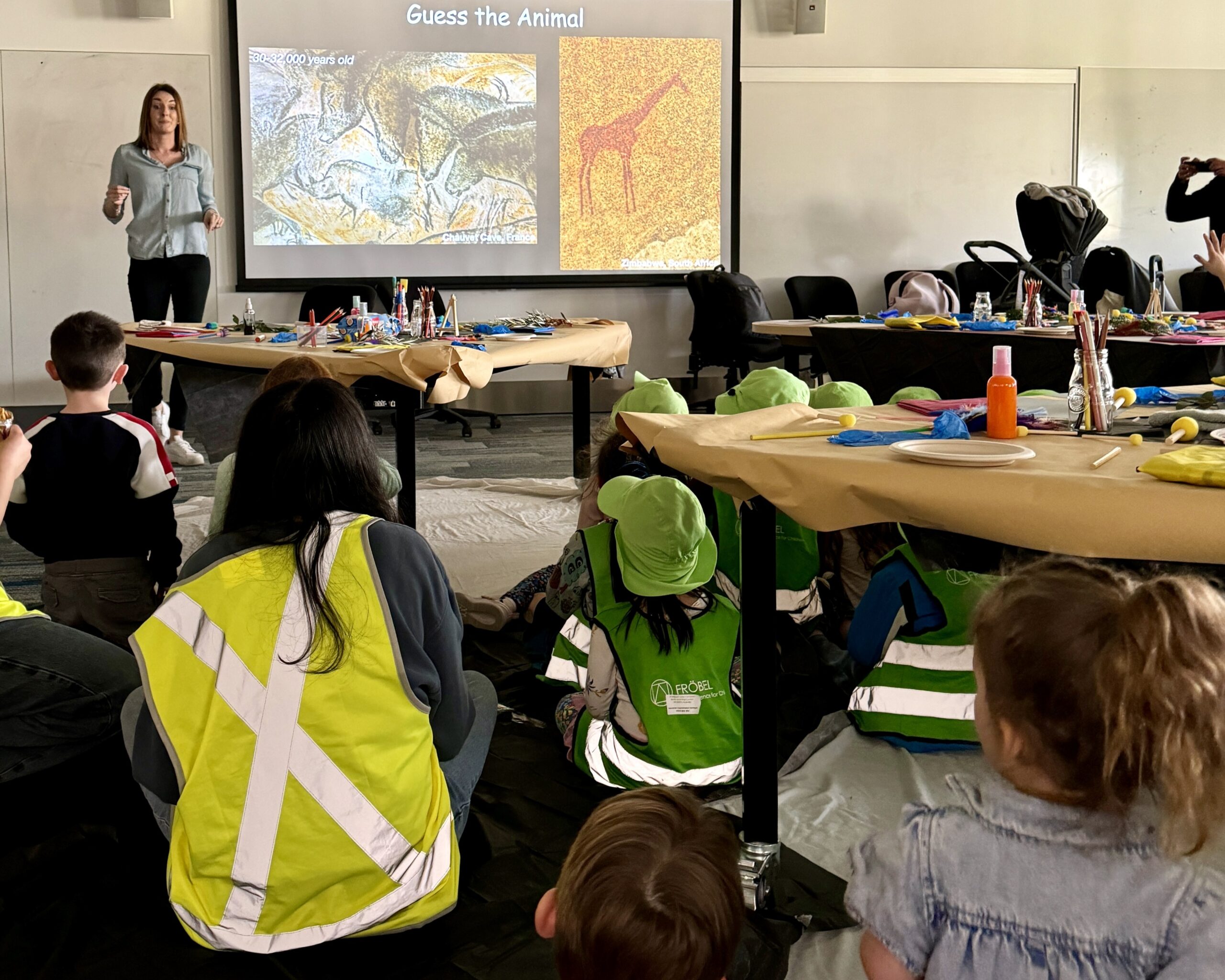
Dr Helen Green running a ‘cave art’ session for children at the University of Melbourne’s School of Geography, Earth and Atmospheric Sciences colloquia program in 2024
At the heart of Rock Art Australia’s mission is our deep commitment to supporting the next generation of Australian two-way scientists and cultural leaders with the knowledge, skills, and relationships needed to protect, conserve, and tell the story of Australia’s ancient past. This commitment comes to life through the work of people like Dr Helen Green, whose journey from young researcher to national leader offers a great example of what is possible when scientific expertise is matched with cultural integrity, long-term collaboration, and purpose-driven mentorship.
Helen first joined the Rock Art Australia-funded Rock Art Dating Project in 2014. By 2018, she had become a Chief Investigator, and today, a decade after first stepping into the field, she sits on the Board of Rock Art Australia and chairs our esteemed Science Advisory Council. Her role as a Research Fellow at the University of Melbourne also sees her mentoring a new generation of scientists, such as PhD student Faris Ruzain, whose work on radiocarbon dating was recently recognised on the national stage as a finalist in the FameLab 2025 Science Communication Competition.
Helen’s impact goes beyond academic mentorship. In 2025, she launched the new Rock Art Australia-funded School Outreach Program in the East Kimberley, developed through long-standing partnerships with the local community, Aboriginal Corporations, schools such as Kalumburu School and East Kimberley College, and researchers across leading Australian universities. The program is an example of true two-way partnerships, engaging young people in remote communities and nurturing future leaders who will care for Country and culture with both ancient knowledge and modern tools.
To read Dr Helen Green’s Q&A about the milestones and motivations that have shaped her journey, including the newly launched School Outreach Program in the East Kimberley, and her vision for the future of collaborative, community-led science, click on the link below.
RAA Funded Research Project Update
Rock Art Australia funded the inaugural School Outreach Program at East Kimberley College
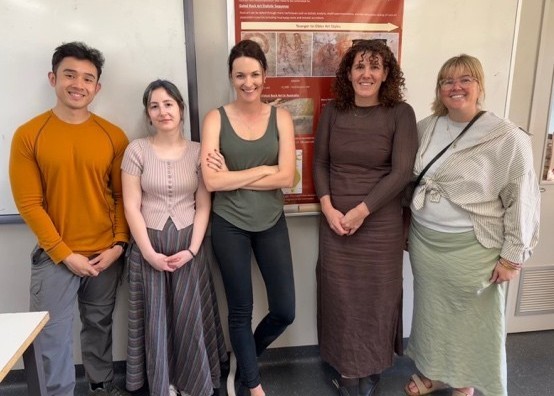
Faris Ruzain, Marina Mitsopolous, Helen Green, Jess Masson (EKC) and Dr Tristen Jones
On August 11th, Rock Art Australia funded the inaugural school outreach program at East Kimberley College, led and coordinated by Dr Helen Green, in collaboration with SAC member and University of Sydney archaeologist Tristen Jones, Master’s student Marina Mitsopoulos, and PhD student Faris Ruzain-both researching rock art in the context of dating and conservation. Delivered in partnership with the Balanggarra Young Rangers Amos Smith and Creshaune Carter, the full-day workshop engaged Year 9 students through a series of hands-on activities including archaeological site recording, geology basics, conservation challenges for rock art, and ranger-led fire management. A key highlight was the two-way learning approach to cultural heritage management, with Marina demonstrating the physio-chemical impacts of fire on cultural pigments, while the Rangers shared their traditional fire knowledge and land management strategies.
The program was extremely well received by students and teachers, who expressed a strong interest in hosting it again next year. It also created meaningful opportunities to connect with the broader community, while providing a platform for university students to build their science communication and outreach skills.
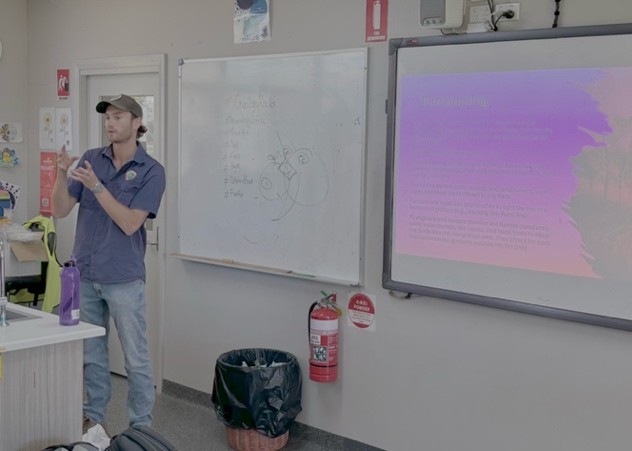
BAC Young Ranger Coordinator Amos Smith presenting about fire management

Faris Ruzain demonstrating an experiment with EKC students
Women’s Cultural Education Engagement Project – Outdoor Schools’s Kimberley Pathways Program

Elders Dorothy Djangara and Bernadette Waina welcomed all visitors to Country and conducted a smoking ceremony to ensure everyone was welcome and culturally safe during their time on Country.
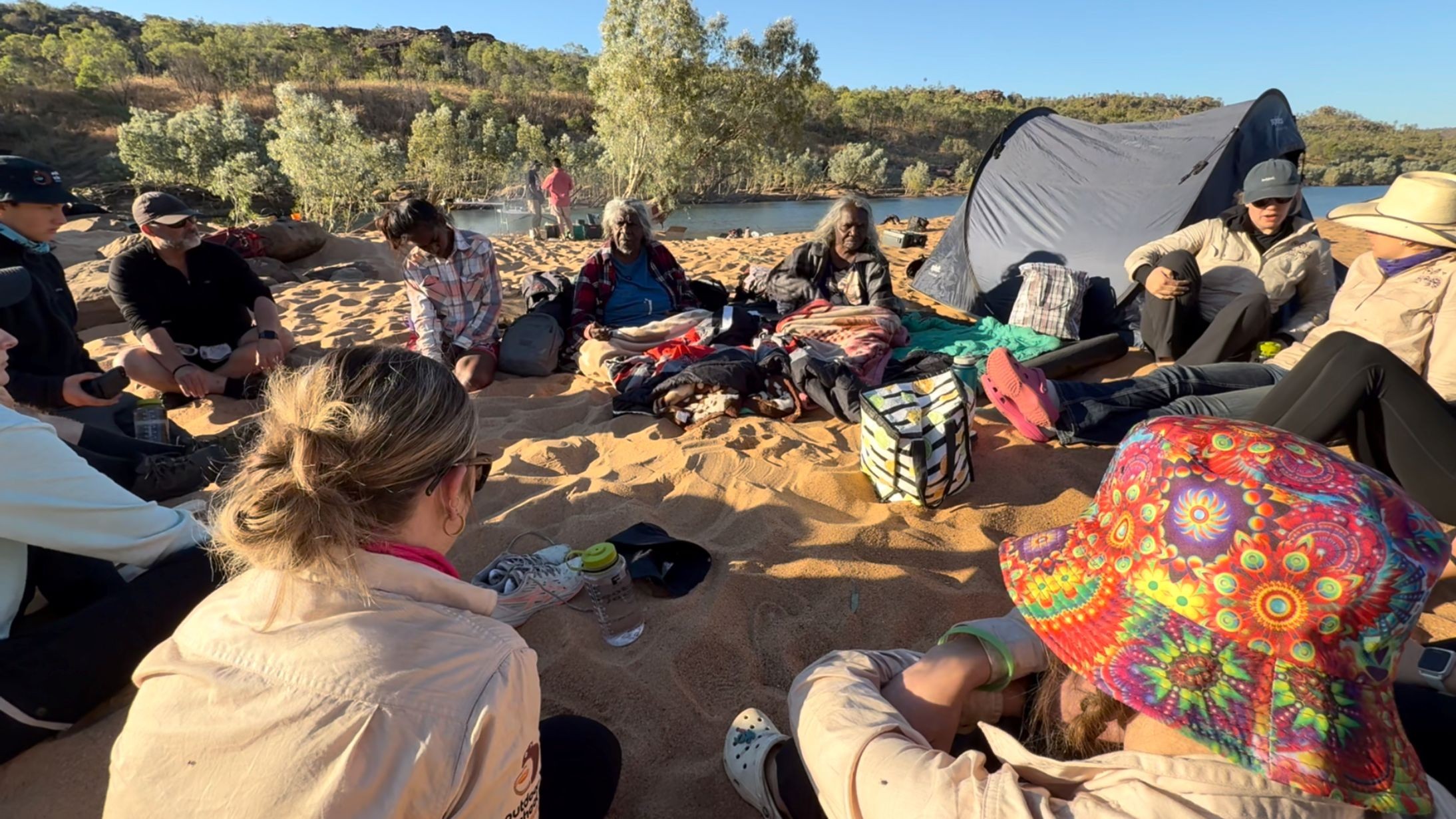
The activities included time to sit and listen to elders sharing their knowledge and stories with the students and younger community members
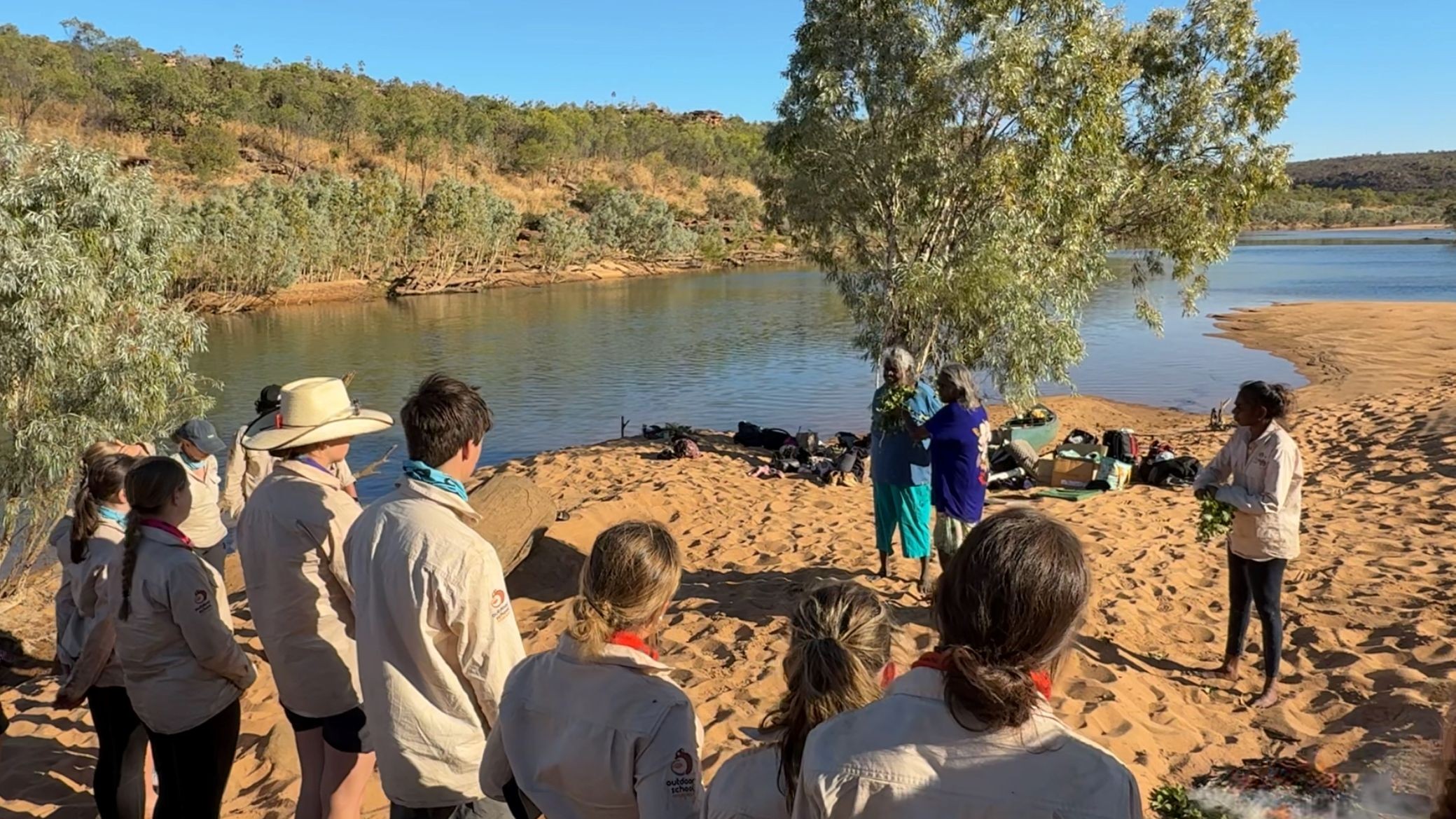
Dorothy Djangara (left) and Bernadette Waina (right) speaking with students and younger community members about culture and answering many questions from students.
Dorothy and Bernadette later engaged the entire student group in a long discussion, sharing cultural stories and answering student questions with generosity and clarity. Ainslie was present throughout these conversations, absorbing the stories of her Elders and contributing her own knowledge, particularly during visits to key rock art sites. Her interpretation of the artwork brought cultural knowledge vividly to life for the students and researchers alike.
Throughout the journey, the leadership and wholehearted engagement of Dorothy, Bernadette, and Ainslie were clearly felt. The planning they brought to their time on Country created a rich, respectful space for cultural exchange and learning. Students had many opportunities for informal conversations with all three women, allowing for meaningful one-on-one discussions that deepened their understanding of Kimberley culture.
The experience highlighted the power of cultural sharing in building mutual understanding and respect, while also modelling effective processes for future community engagement in research.
Feedback from all participants, particularly Dorothy, Bernadette, and Ainslie, was overwhelmingly positive, with strong endorsement for continuing this style of engagement to support younger generations in learning Culture both within and beyond the community.
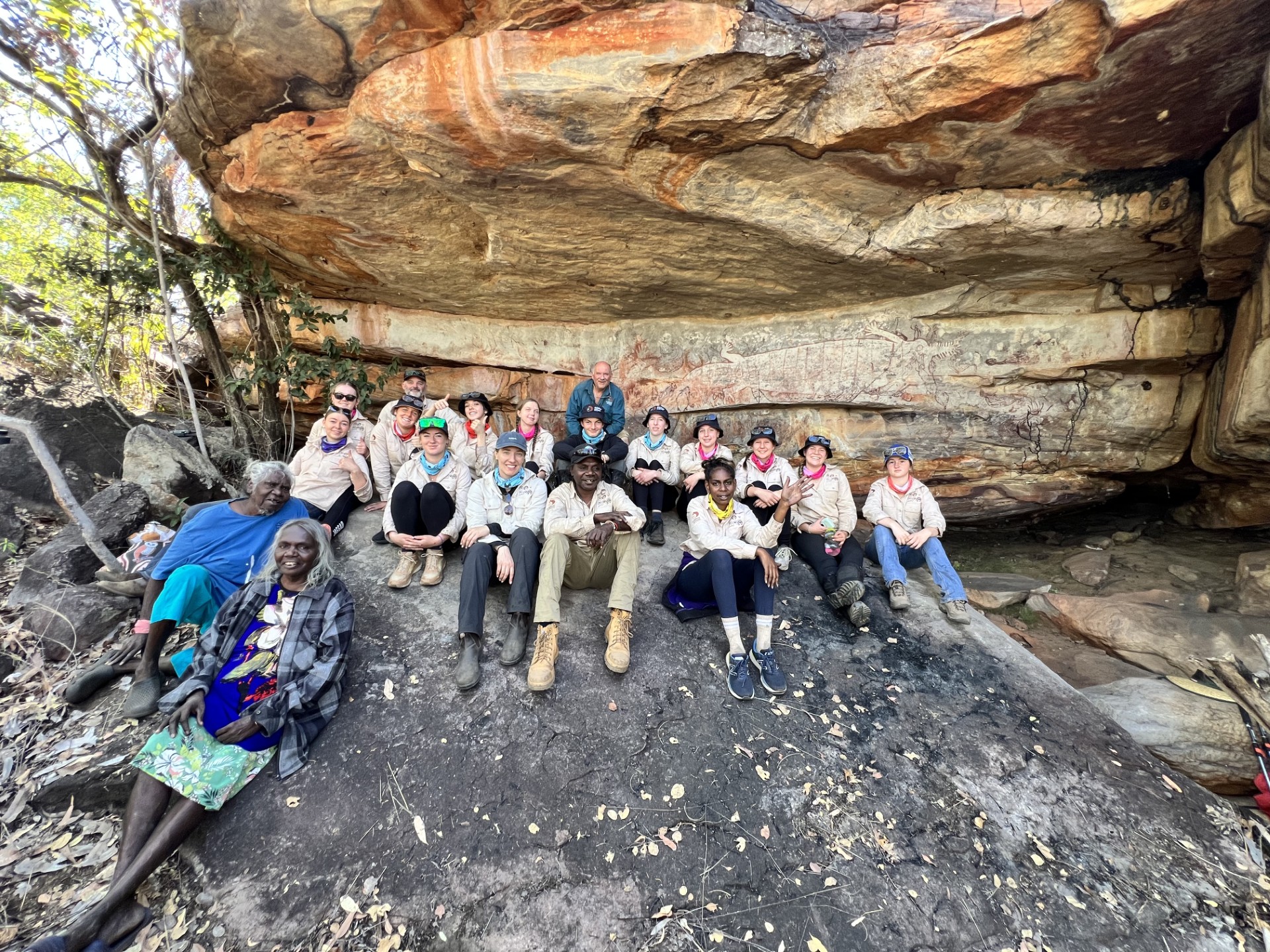
Elders Dorothy Djangara and Bernadette Waina plus community members Ainslie Donation and Ian Waina brought the Outdoor School students to several cultural sites during the Women’s Cultural Education Project.
Kimberley Rock Art Virtual Reality Program for immersive learning, research, conservation and engagement
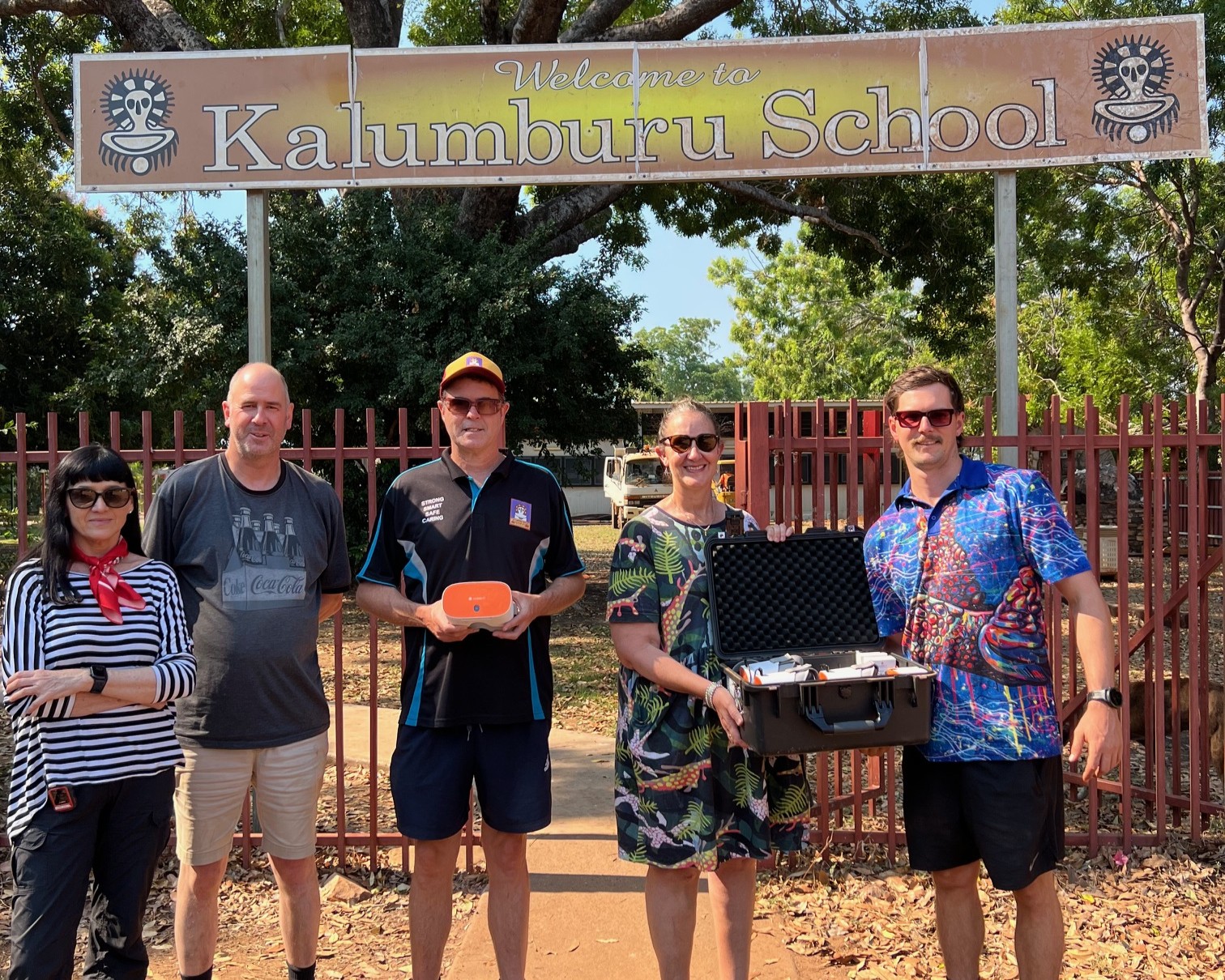
Left to right: Louise Shewan, David Barnes, Principal Simon Duncan, Deputy Principals Samantha Wright and Trent Ryan receiving the VR headsets kindly provided by RAA
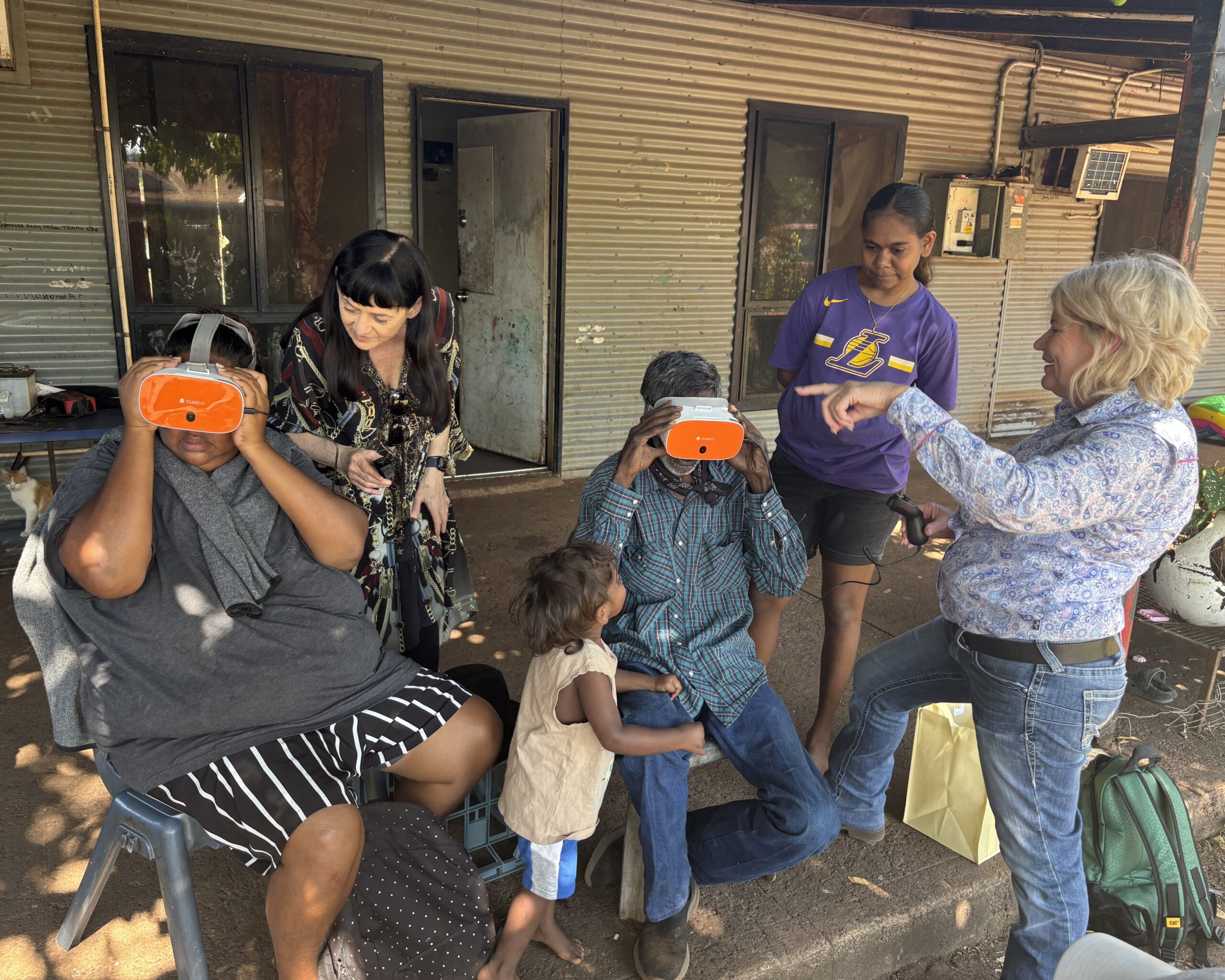
Left to right: Traditional Owner Augie Unghango and family, Louise Shewan and Pauline Heaney

David Barnes, Louise Shewan and Kalumburu Remote Community School students
The Virtual Reality (VR) team returned to the Drysdale River National Park in August for fieldwork and a visit to the Kalumburu Remote Community School to engage with students and deliver 12 ClassVR headsets donated by Rock Art Australia. The team also had the opportunity to spend time with Augie Unghango, the Senior Traditional Owner on the RAA supported Rock Art Dating projects, and his family.
Louise Shewan, David Barnes, Pauline Heaney and Traditional Owner Ainslie Donation spent time in the field to collect thousands of photographs, 360-degree and aerial footage at selected Kimberley rock art sites. The resulting 3D models and movies will contribute to a growing library of cultural heritage material for deployment in VR headsets for education and conservation purposes. With help from Cecilia Myers, the team was able to process large datasets overnight in readiness for their visit to the school. Models created from photographs acquired just two days earlier, were available on the headsets for the students to experience!
A highlight of the fieldwork was a collaboration with the Outdoor School team led by Paul Hartley. The large group of students and teachers was joined by Helen Green, Faris Ruzain and traditional Owners Ian Waina, Bernadette Waina, Dorothy Djanghara and Ainslie for a day of cultural exchange and knowledge sharing at key rock art sites.
Back in Kalumburu and armed with two boxes of RAA-supplied headsets, Louise and David spent time with primary, middle and senior school students, exploring rock art shelters and nearby water features in VR. Creative activity sheets designed by Pauline for each of the sites were provided to enable the students to learn about rock art motifs and stories as they viewed the models and movies in the headsets.
Louise, David and Pauline will return to Kalumburu next year to work further with the teachers and students on the exploration of the rock art sites in VR, and also to share the techniques used to create the VR experiences, with a view to increasing student engagement in STEM activities especially in the context of their cultural heritage.

Educational worksheets created by Pauline Heaney
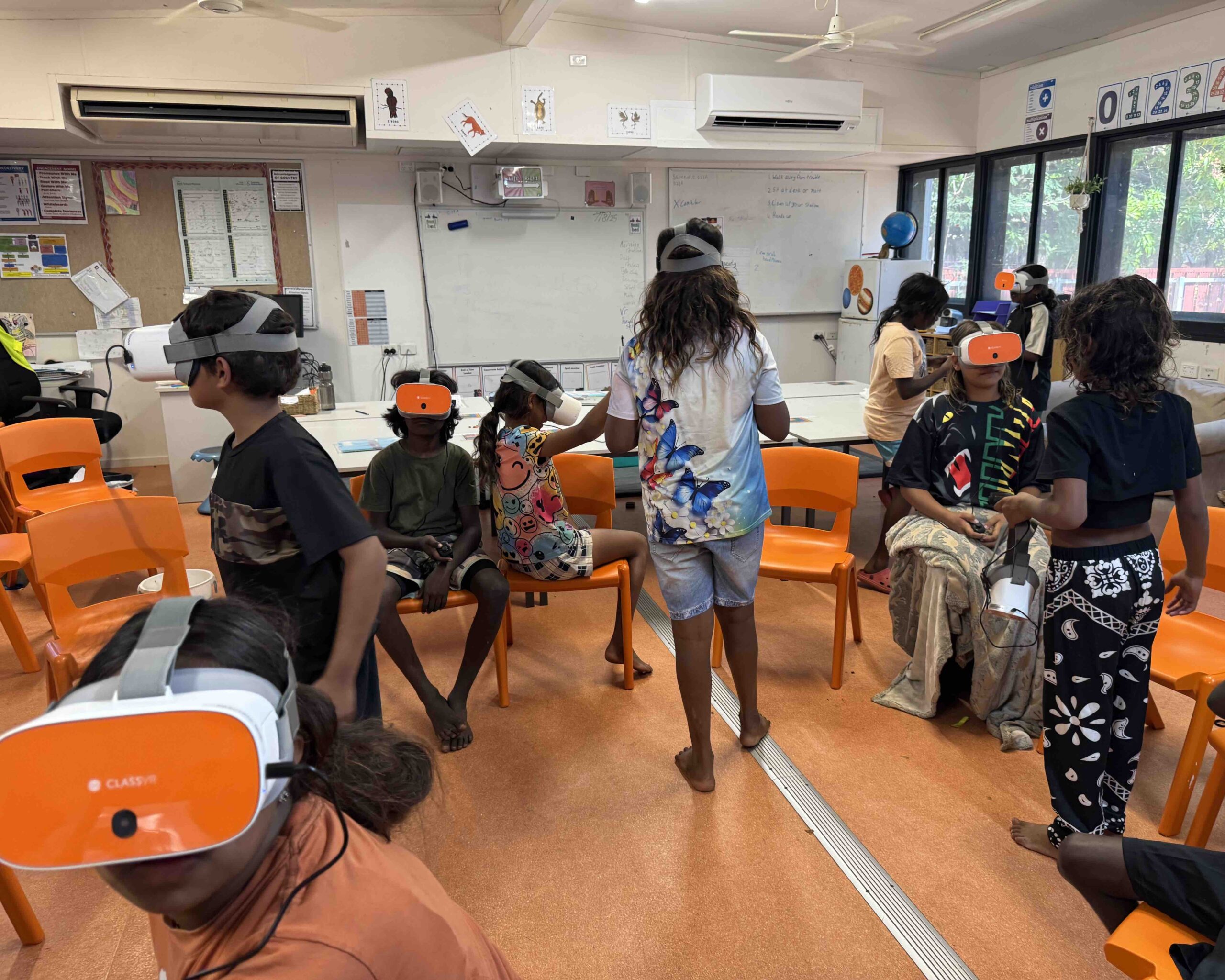
Kalumburu Remote Community School students enjoying VR
The MAGNT Rock Art Digitisation Project
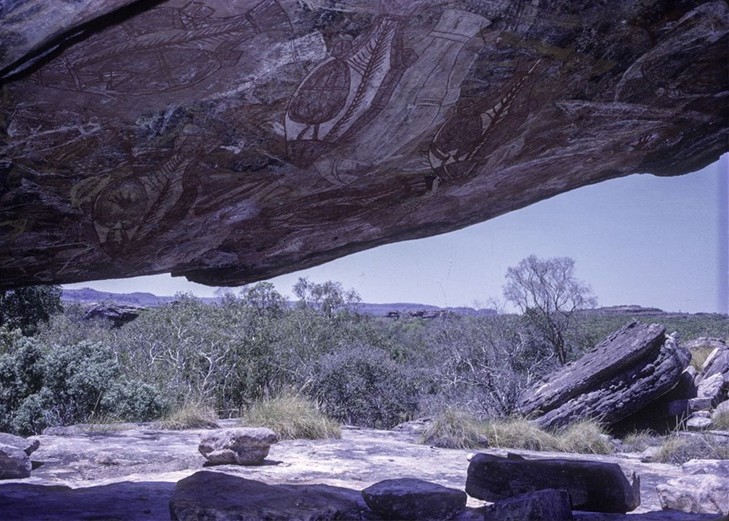
Ubirr – View from protected shelter towards the main escarpment. Bunidj, Manilakarr and Mandjurlgunj caretakers Kakadu National Park (established 1979). Photograph: George Chaloupka, September 1973
Digitised courtesy of Rock Art Australia
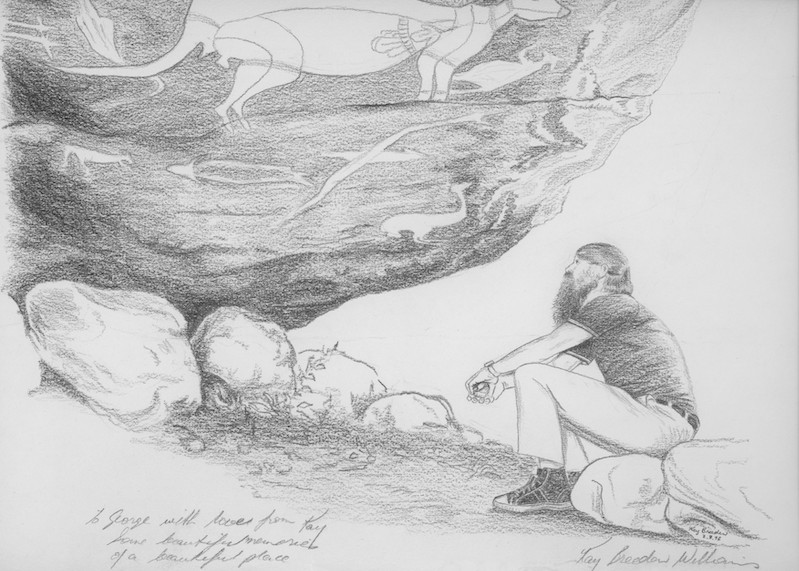
From the archive – Scanned image of pencil drawing by Kay Breeden Williams, 1972 gifted to George Chaloupka
The 2023–2025 Rock Art Digitisation Project at the Museum & Art Gallery of the Northern Territory ( MAGNT), proudly funded by Rock Art Australia, has delivered great results and lasting impact. Focused on the George Chaloupka Rock Art Archive, the project has safeguarded one of the nation’s most important collections of cultural and archaeological significance.
Exceeding expectations, the team at MAGNT has successfully digitised and preserved over 25,000 colour transparencies, well above the original estimate. Using international best-practice standards, state-of-the-art equipment, and culturally sensitive workflows, the project created high-resolution digital copies of invaluable records that span decades of research and fieldwork across Arnhem Land.
Equally important was the physical conservation of associated materials, sketches, notes, maps, reports, photographs, and audio tapes, some dating back to the 1960s. Purpose-built storage and improved housing ensure these items are now secure for the long term.
Crucially, the project has reconnected MAGNT with many Traditional Owner groups, strengthening relationships and laying the foundation for ongoing collaboration. We look forward to following MAGNT’s future plans, which include working closely with community on culturally appropriate access protocols and enhancing image data to improve searchability and research use.
This has been a highly successful and meaningful initiative. It has not only preserved a nationally significant archive but also brought communities, heritage, and technology together in a powerful and enduring way.
Rock art, archaeology and climate change in the Wulk (Red Lily Lagoon) region, Manilakarr Clan Estate, Western Arnhem Land

Sebastian Nagrrugrruba Galbirrbirr (Njanjma Rangers) at the Old Man’s Hand site, Red Lily, west Arnhem.
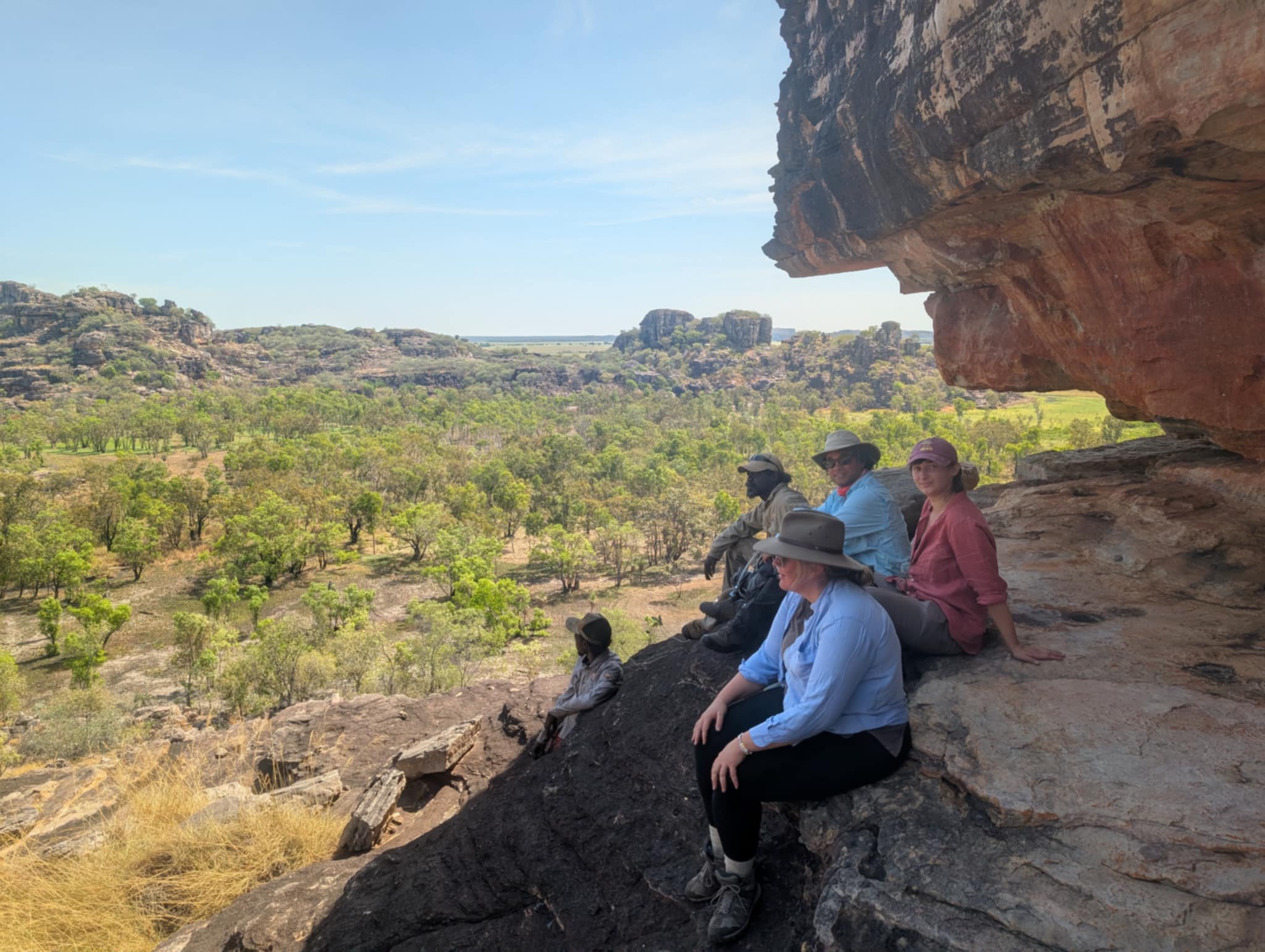
Maries Descottes (Toulouse Jean Jaurès University), Dr Jacob Bongers (University of Sydney), Sebastian Nagrrugrruba Galbirrbirr (Njanjma Rangers); Jacob Jr Nayinggul (Njanjma Rangers); Dr Tristen Jones (University of Sydney) looking out towards Red Lily high up in the escarpment taking in the view after recording some rock art (bim) sites.
In early August Dr Tristen Jones and Dr Jacob Bongers from The University of Sydney, together with visiting doctoral student Ms Marie Descottes from Toulouse Jean Jaurès University, travelled to western Arnhem Land to work with the Njanjma Rangers and Senior Traditional Owner for Manilakarr Clan Estate, Mr Alfred Nayinggul to document key rock art sites around Red Lily Lagoon as scoping work for future research projects.
Dr Jones and Dr Bongers, together with Prof Chris Clarkson (Griffith University) and Dr Kasih Norman (Griffith University) and from eight research institutions, are currently waiting for the outcome of a grant application in the current round of Australian Research Council Linkage Scheme. If successful the project titled “Human responses to rapid post-glacial sea level rise in the Greater Red Lily Lagoon Area, Arnhem Land” will commence in Arnhem Land in 2026.
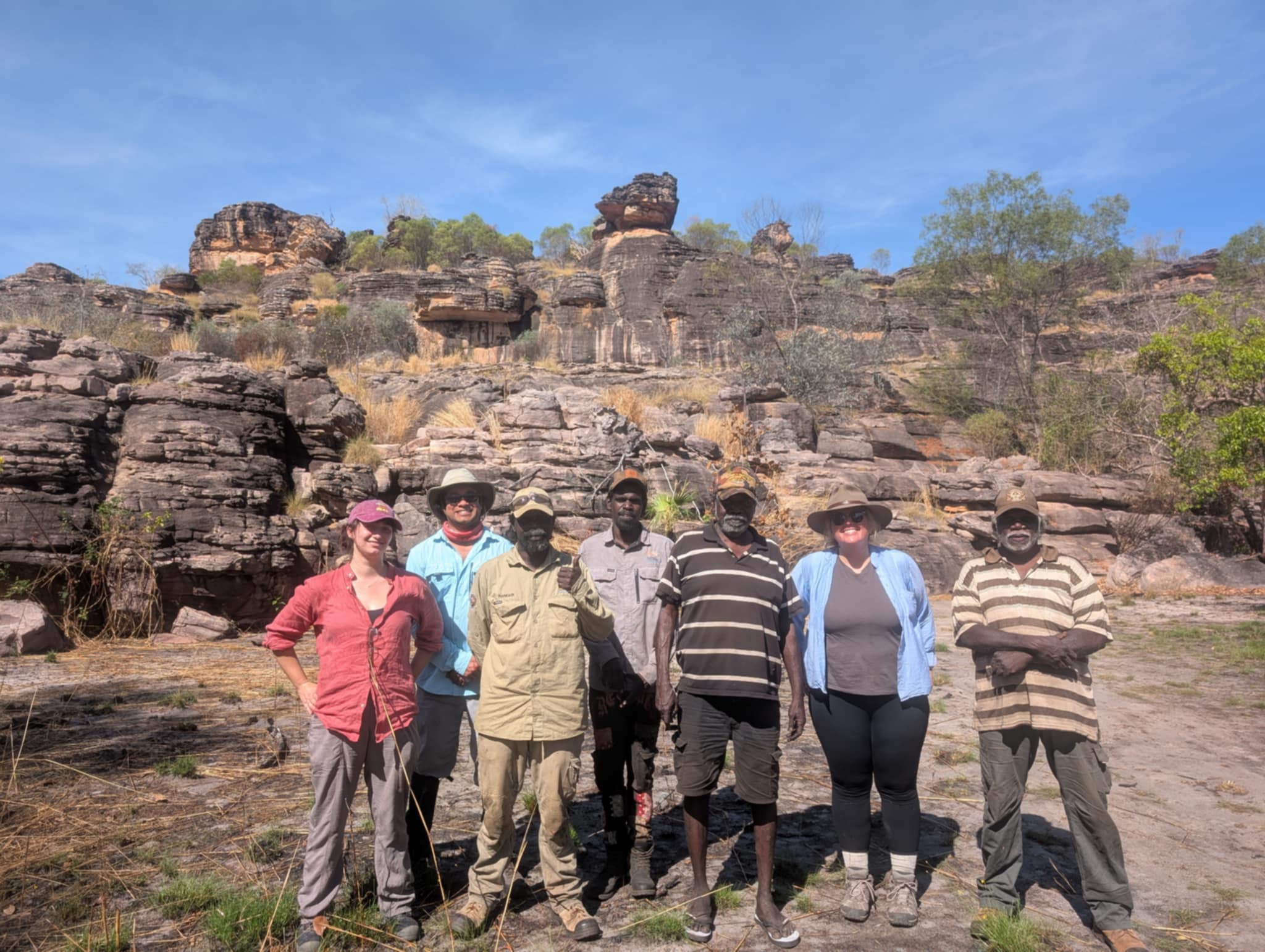
Maries Descottes (Toulouse Jean Jaurès University), Dr Jacob Bongers (University of Sydney), Sebastian Nagrrugrruba Galbirrbirr (Njanjma Rangers); Jacob Jr Nayinggul (Njanjma Rangers); Alfred Nayinggul (Senior Traditional Owner Manilakarr, Njanjma Rangers); Dr Tristen Jones (University of Sydney); Walter Nayinggul (Njanjma Rangers)
New Publications
Finger flutings at New Guinea II Cave, lower Snowy River Valley (Victoria) GunaiKurnai country
Madeleine Kelly, Bruno David, Olivia Rivero Vilá, Diego Garate Maidagan, Jean-Jacques Delannoy, Russell Mullett, Jessie Birkett-Rees, Fiona Petchey, Aoife Barker, Lee J. Arnold, Helen Green, Joanna Fresløv, GunaiKurnai Land and Waters Aboriginal Corporation. Published in Australian Archaeology
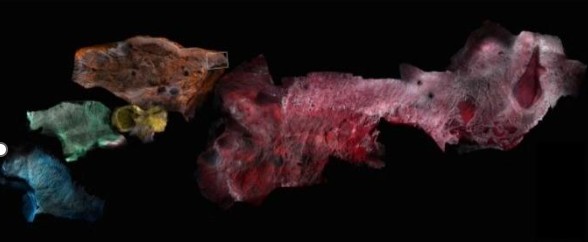
Underside plan view of the decorated section of the cave, showing the extent of Panel 1 -blue, Panel 2 -green, Panel 3 -yellow, Panels 4–5
The paper explores a remarkable site deep in GunaiKurnai Country, where over 950 ancient finger flutings were deliberately etched into glittering cave walls. Far from casual markings, these gestures connect to ancestral spiritual practices and the powers of mulla-mullung (medicine people), offering rare insight into the cultural and ceremonial use of the caves.
Dating the Aboriginal Rock Art of the Kimberley (2018–2024)
This landmark project set out to build the first reliable timeline for the Aboriginal rock art of the Kimberley, WA. By combining four advanced dating methods with new knowledge of sandstone surfaces, researchers have been able to create the most detailed sequence of Kimberley rock art to date. For the first time, art styles can be scientifically linked to specific periods, unlocking new insights into one of the world’s oldest continuous cultures. The project brought together a wide network of people and organisations, creating lasting benefits beyond the research itself.
Collaboration was central, involving 10 organisations across universities, government, industry, Indigenous groups and not-for-profits.
By providing a robust timeline of Kimberley rock art, this research strengthens heritage conservation, supports cultural tourism, and deepens understanding of Australia’s ancient cultural legacy, all with important economic, cultural and social benefits for Indigenous communities and the wider region. It supported:
- 13 Chief Investigators leading the project
- 16 postgraduate students in Australia (4 PhDs and 6 Masters) and 3 international PhD students
- 3 postdoctoral researchers and 36 other personnel across the project’s lifespan
The project has already delivered 8 major research outputs, while also training the next generation of experts in archaeology, heritage science and conservation. One such publication resulting from the project is:
The origin, evolution and life cycle of rock art shelters in the Kimberley Basin of NW Australia
Andrew Gleadow, Helen Green, Damien Finch, Samuel Boone, David Fink, Réka-Hajnalka Fülöp, Alexandru Codilean, Augustine Unghango. Published in WILEY Online Library
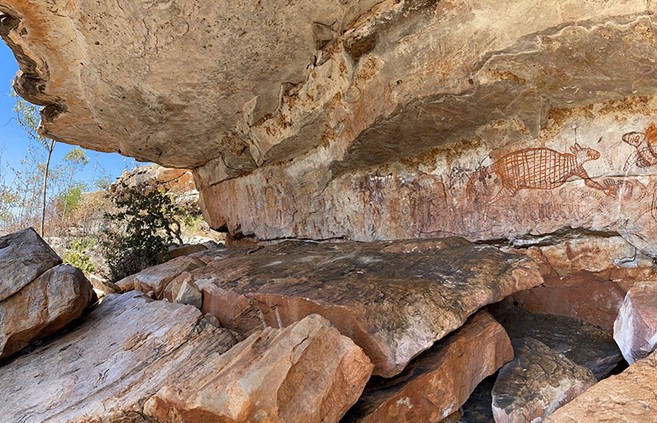
The Pundawar Manbur rock shelter in the Warton Sandstone, north Kimberley
This comprehensive study reveals how the iconic sandstone shelters that protect ancient Aboriginal rock art in the Kimberley region form, evolve, and eventually collapse. Rather than being shaped by erosion, these shelters develop through natural cracking and structural failure within the rock itself.
Over tens of thousands of years, this slow process causes slabs to fall from cave ceilings, creating new surfaces for the art, but also threatening older paintings with destruction. By outlining a four-stage life cycle of shelter development, the researchers show that understanding the mechanics behind their formation is vital for protecting these globally significant cultural sites.
The findings offer new insights not only for heritage preservation in the Kimberley, but also for rock art sites in similar sandstone landscapes around the world.
Apply for Rock Art Research Funding
At Rock Art Australia, we bring scientific research and Aboriginal cultural knowledge together to study rock art provinces of Australia. We study them to understand the history of Aboriginal Australia and its significance in the global narrative of human origins and to ensure its protection.
We initiate and support integrated, multi-disciplinary scientific research which is co-developed with Aboriginal communities to ensure it meets the needs for the Aboriginal people of the region. We actively foster engagement with Country and culture.
To learn more about Rock Art Australia’s research priorities and how to apply for RAA research funding, please visit our website by clicking the link below.
For general enquiries please contact: grants@rockartaustralia.org.au
Events
Past Events
Film Screening of Two Ways: The Kimberley Rock Art Legacy
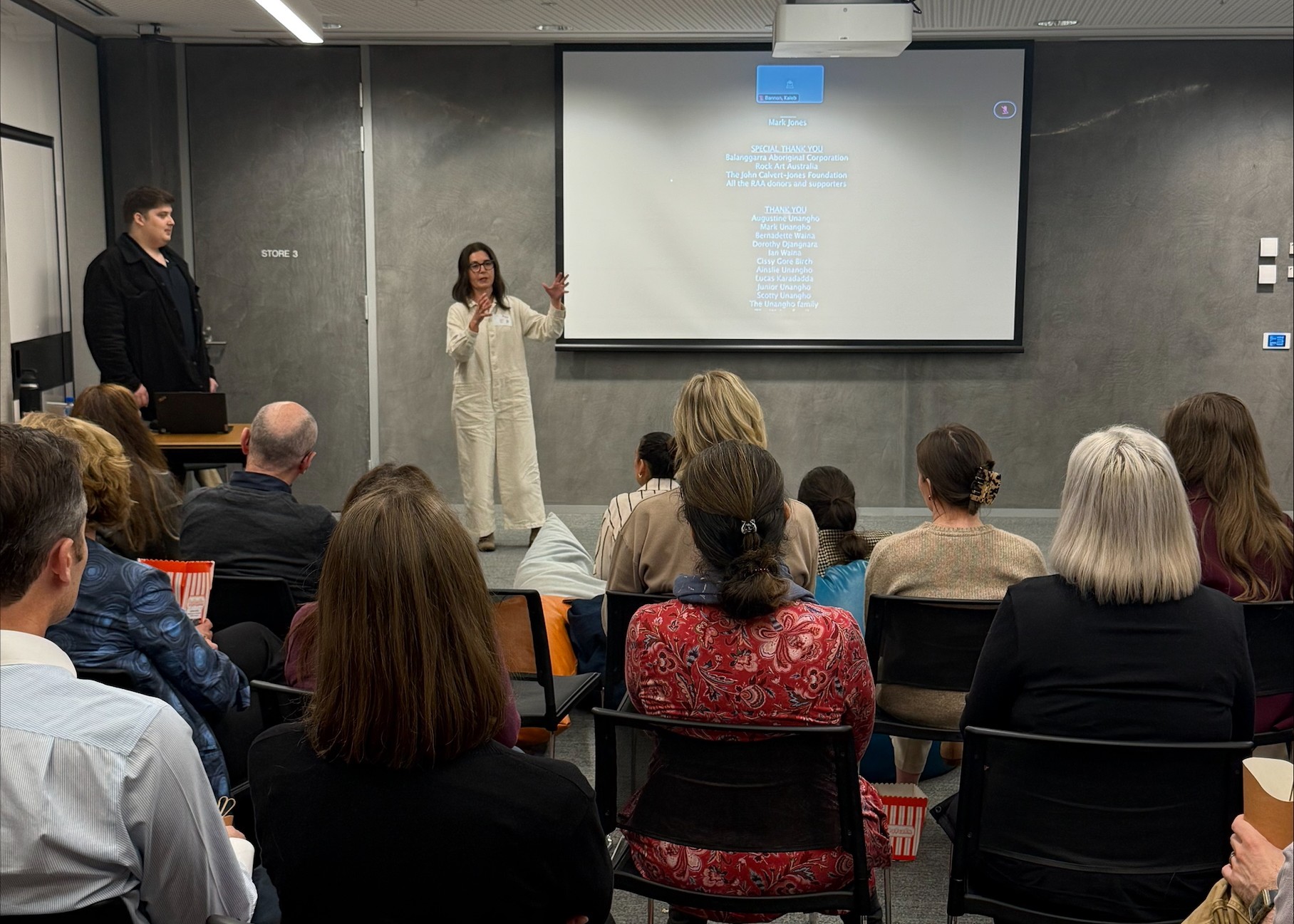
Left: Kaleb Bannon, First Nations Advisor | First Nations and Human Rights, Woodside Energy, and presenting: RAA CEO Samantha Hamilton
In July, Rock Art Australia hosted a screening of the powerful documentary Two Ways: The Kimberley Rock Art Legacy at Woodside Energy in Perth as part of NAIDOC Week celebrations. The event attracted over 300 staff both in person and online, offering an opportunity to share the remarkable story of Australia’s oldest rock art through the voices of Traditional Owners and researchers.
The film, set in the world-renowned rock art galleries of the Kimberley, highlights over a decade of collaboration between scientists and the Balanggarra people. Through Two Ways, RAA is raising awareness of Australia’s deep cultural heritage, while also supporting cultural competency, education, and reconciliation in corporate and community settings. It’s a compelling tool to inspire reflection, respect, and shared responsibility for preserving Australia’s cultural heritage.
The 10th World Archaeological Congress (WAC-10) in Darwin, 22-28 June 2025
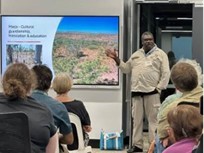
Gordon Jnr Smith, Wilinggin Aboriginal Corporation
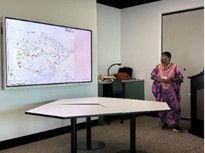
Catherine Namono, Curator, RARI Academic Collections, School of Geography, Archaeology & Environmental Studies, University of the Witwatersrand, Johannesburg, South Africa
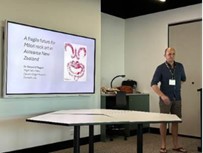
Gerard O’Regan, Ngāi Tahu tribe, Tūhura Otago Museum, Aotearoa New Zealand
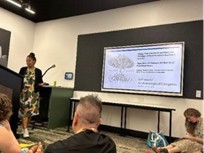
Roxanne Tsang, University of Oxford; University of Papua New Guinea
RAA CEO Samantha Hamilton attended the 10th World Archaeological Congress (WAC‑10), held in Darwin from 22–28 June 2025. This was a landmark event, not only marking the first time WAC convened in Australia, but also drawing archaeologists, Indigenous leaders, heritage experts, and students from over 70 countries.
Each day featured dedicated rock art sessions, offering a rare and invaluable opportunity to explore global perspectives on conservation, management, and ethical collaboration. These discussions underscored the importance of engaging respectfully with Indigenous communities and sharing strategies across borders to protect and preserve humanity’s earliest cultural expressions.
WAC‑10 balanced rigorous scholarship with meaningful cultural exchange by inviting attendees to connect with Indigenous Australian traditions through performances, workshops, storytelling, and tours guided by custodians of Country.
It was a global gathering committed to reframing archaeology through inclusivity, intercultural partnership, and shared responsibility for our cultural heritage. The day-to-day rock art sessions and international collaboration served as powerful reminders: safeguarding heritage demands collective action, grounded in mutual respect and informed by diverse ways of knowing.
Congratulations to the organisers on such an inclusive and enlightening event.
Support the future of Australia’s deep history
As we look ahead to the final months of the year, your continued support remains critical. Rock Art Australia relies on philanthropic investment to fund pioneering research, support Aboriginal-led cultural initiatives, and train the next generation of scientists and cultural custodians. Whether through a donation to our General Research Fund, attendance at our events, or sharing this newsletter with your network, your involvement makes a real and lasting impact.
Together, we are helping to preserve, protect, and share one of the world’s most extraordinary cultural legacies. Thank you for being part of this important journey.

